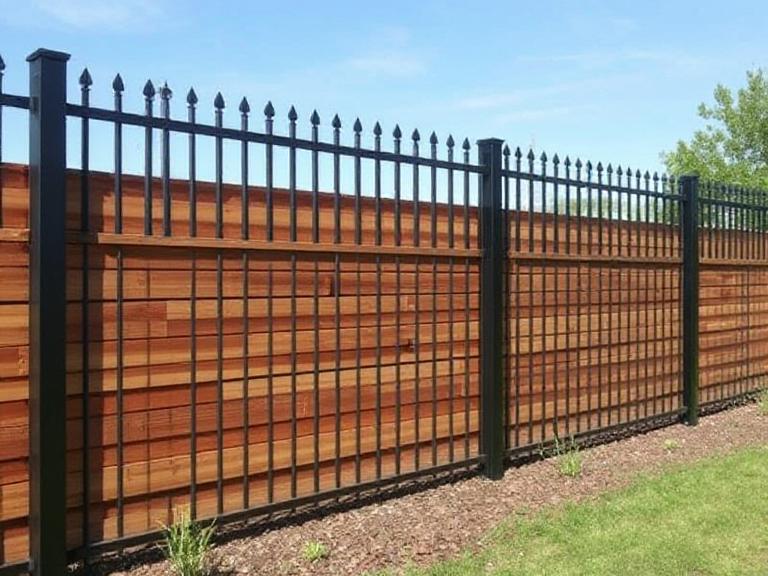
Are Metal Fence Panels Cheaper than Wood?
Share
Table of Contents Metal Fence Panels Cheaper than Wood
- Introduction
- Cost Comparison: Metal vs. Wood
- Factors Affecting Fence Costs
- Longevity and Maintenance Costs
- Aesthetic and Design Considerations
- Featured Product: PATAVIN Privacy Panels for Outside LINE POST KIT 8' - L8
- Environmental Sustainability
- Installation Costs and Ease
- Conclusion: Which is Cheaper Overall?
- Summary Table
- References
Introduction Metal Fence Panels Cheaper than Wood

When planning a new fence, one of the most common questions homeowners face is: Are metal fence panels cheaper than wood? While wood has long been the go-to option for privacy and aesthetics, metal fencing—particularly aluminum and steel—has grown in popularity for its durability and low maintenance requirements. But cost is often the deciding factor, and the answer isn’t always straightforward. This guide explores the initial purchase price, installation expenses, maintenance costs, and long-term value of both materials so you can make the most informed decision.
Cost Comparison: Metal vs. Wood
The initial cost of fencing materials varies significantly depending on the type of wood or metal, the height of the fence, and local market prices. Here’s a breakdown:
Average Material Costs
- Wood fence panels: Typically range from $15 to $30 per linear foot for treated pine, cedar, or redwood.
- Metal fence panels (aluminum or steel): Range from $25 to $60 per linear foot for decorative and privacy options.
At first glance, wood may appear cheaper upfront, especially for basic treated lumber. However, metal's long lifespan and lower maintenance can offset the higher initial cost over time. Cost of Privacy Fence Per Foot 2025
Factors Affecting Fence Costs
- Material grade: Premium cedar or hardwood fencing can cost more than basic aluminum panels.
- Design complexity: Intricate patterns or custom finishes raise both wood and metal prices.
- Local availability: Regional supply shortages can affect pricing drastically.
- Height and length: Taller fences require more material and support structures.
Longevity and Maintenance Costs
One of the major cost considerations is not just the initial purchase but the total cost over the fence’s lifespan.
Wood Fences
- Require staining or sealing every 1–3 years.
- Prone to rot, insect damage, and warping.
- Average lifespan: 10–15 years with regular upkeep.
Metal Fences
- Rust-resistant aluminum or galvanized steel can last 25–50 years.
- Minimal maintenance—occasional cleaning is usually sufficient.
- No repainting or sealing required for powder-coated finishes.
Bottom line: While wood costs less initially, metal often wins on long-term value due to lower maintenance and longer life.
Aesthetic and Design Considerations
Design preferences play a role in the cost and final decision.
- Wood: Offers a warm, natural look and flexibility in painting or staining to match the home’s style.
- Metal: Modern, sleek designs with customizable panel shapes, colors, and finishes.
Featured Product: PATAVIN Privacy Panels for Outside LINE POST KIT 8' - L8

For those seeking a durable, modular, and visually appealing fencing option, the PATAVIN KIT L8 stands out as a high-performance solution.
Product Overview
- Material: Powder-coated aluminum (rustproof & weather-resistant).
- Dimensions: 2.16’’ x 2.16’’ x 96" post.
- Compatibility: Designed for 5/4 wood boards and 1’’ composite boards.
- Installation: Nail-free sliding rail system—no drilling tools required.
Key Features
- Instant assembly: Modular setup with secure plank insertion.
- Universal compatibility: Works with wood, composite, and custom finishes.
- Industrial durability: Corrosion-resistant aluminum for permanent outdoor use.
- Ideal for yard partitions, patio screens, and balcony barriers.
What’s in the Box
- 1 x 96’’ line post
- 1 x anchor plate
- 1 x post cap
- 1 x railblock
- 6 x 1/2" spacers
- 4 x bolt screws
- 1 x Allen key
- 1 x foot cover
- Installation guide
Why it matters: Products like the PATAVIN KIT L8 blend the durability of metal with the customizable look of wood or composite, giving homeowners the best of both worlds—long-term cost savings and aesthetic flexibility.
Environmental Sustainability
- Wood: Renewable resource but requires treatments that may involve chemicals.
- Metal: Often made from recycled materials and fully recyclable at end of life.
If sustainability is a key factor, both options can be eco-friendly depending on sourcing and disposal practices.
Installation Costs and Ease
Installation costs can vary based on complexity and labor rates.
- Wood fencing: Heavier and may require more precise post alignment, increasing labor time.
- Metal fencing: Prefabricated panels and modular kits like PATAVIN can reduce installation time and cost.
Conclusion: Which is Cheaper Overall?
In short, wood fence panels generally cost less upfront than metal panels. However, when factoring in maintenance, longevity, and potential replacement costs, metal can often be the more economical choice in the long run—especially with modern modular systems like the PATAVIN KIT L8 that combine durability and style.
Summary Table
| Criteria | Wood Fence Panels | Metal Fence Panels |
|---|---|---|
| Initial Cost | Lower | Higher |
| Maintenance | High (staining, sealing) | Low (occasional cleaning) |
| Longevity | 10–15 years | 25–50 years |
| Aesthetics | Warm, natural look | Modern, sleek design |
| Installation | Labor-intensive | Faster with modular systems |
| Sustainability | Renewable resource | Often recycled & recyclable |
